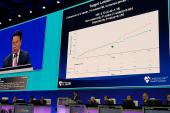BIOFLOW V: Orsiro Still Offers Some Benefits at 5 Years
Unlike in earlier reports, though, the difference in TLF favoring the ultrathin-strut DES over Xience was no longer significant.

Final 5-year follow-up from the BIOFLOW V trial continues to show advantages for the ultrathin-strut bioresorbable-polymer Orsiro DES (Biotronik) over the thin-strut, durable-polymer Xience (Abbott), with reductions in target-vessel MI and stent thrombosis.
While rates of TLF had been lower with Orsiro versus Xience at 1, 2, and even 3 years, however, the difference had become nonsignificant by 5 years, David E. Kandzari, MD (Piedmont Heart Institute, Atlanta, GA), reported this week at CRT 2022 in Washington, DC.
BIOFLOW V was designed as a noninferiority trial, with the composite endpoint of TLF—cardiovascular death, target-vessel MI, and clinically driven TLR—at 12 months as the primary endpoint. It came as unexpected good news, then, that Orsiro proved superior in that time frame, Kandzari told TCTMD. “Today, in general, the outcomes that we observe with contemporary drug-eluting stents are so good that in a conventional noninferiority study it’s very difficult to show superiority in any one feature.”
After years of data favoring Orsiro, the expectation was to see that continue, Kandzari said. That didn’t quite happen. “Fundamentally, the differences do persist out through 5 years, although they don’t per se meet statistical significance for target lesion revascularization and target lesion failure,” he said.
This shift doesn’t represent an “attrition of efficacy,” he noted, but rather could be explained by gradual loss of power as patients are lost to follow-up and the “noise” resulting from a rising number of non-stent-related events, which may “start to mute the potential differences as time goes on.”
Still, Kandzari stressed, the 5-year data are “meaningful.” They contribute to a consistent body of evidence, he said—citing SORT-OUT IX, SORT-OUT X, and BIOSTEMI as examples—that “highlight greater efficacy and/or safety with the ultrathin-strut stent design, and finally now this has been amplified in three different meta-analyses, as well.”
Davide Capodanno, MD, PhD (University of Catania, Italy), commenting on the new findings for TCTMD, said that 5-year follow-up is important to regulators and others because it provides an opportunity to see whether the expected benefit from biodegradable-polymer stents is maintained.
What the BIOFLOW V data suggest, he wrote in an email to TCTMD, is that “the degradation of the polymer is not a major determinant, at least when compared with a durable biocompatible polymer, and actually some attrition in TLF occurs (ie, no longer significantly different at 5 years).” Instead, it appears that strut thickness is playing a bigger role.
BIOFLOW V
For the BIOFLOW V trial, 1,334 patients were randomized 2:1 to the sirolimus-eluting Orsiro (60-μm struts, with a polymer that resorbs by around 15 to 18 months) or the everolimus-eluting Xience (81-μm struts, with a permanent polymer).
As previously reported, in the first 12 months, the Orsiro stent had a lower rate of TLF compared with Xience, driven by less target-vessel MI, results which supported the 2019 US Food and Drug Administration approval. Subsequent 2-year follow-up also showed significant differences in the individual endpoints of target-vessel MI and clinically driven TLR.
At 5 years, follow-up data were available for 91.3% of patients in each treatment group. The primary endpoint and its various components all trended in the same direction, though only target-vessel MI reached statistical significance. Very late definite/probable stent thrombosis, occurring between > 1 year and ≤ 5 years, also was less common with Orsiro than with Xience.
BIOFLOW V: Outcomes at 5 Years
|
|
Orsiro (n = 884) |
Xience (n = 450) |
P Value |
|
TLF |
13.2% |
16.5% |
0.126 |
|
Cardiac Death |
2.7% |
2.0% |
0.555 |
|
Target-Vessel MI |
7.3% |
11.5% |
0.021 |
|
Ischemia-Driven TLR |
6.3% |
8.3% |
0.223 |
|
Very Late Stent Thrombosis |
0.1% |
1.0% |
0.047 |
Kandzari said that, in his view, the move toward ultrathin struts is a relatively small, incremental piece in the evolution of DES.
“When we consider the investment that industry has made—in different drugs, different polymers, bioresorbable scaffolding—constructing ultrathin-strut designs to me seems like the least burdensome path [toward] improving drug-eluting stent efficacy and safety,” he commented. Although not all trials will show an advantage for ultrathin-strut DES, Kandzari acknowledged, there are now not only positive trial data but preclinical studies and registry findings. “I think we have enough information. It’s just an issue of industry’s willingness to change their manufacturing processes, and there is an expense associated with that.”
It’s hard to predict whether there will be continued industry investment in novel DES, he said. But what the experience with ultrathin struts does suggest, Kandzari added, “is that when we thought we couldn’t do better, there is an opportunity to do just a little bit better, and I think that’s encouraging.”
When we thought we couldn’t do better, there is an opportunity to do just a little bit better, and I think that’s encouraging. David Kandzari
As for potential drawbacks to ultrathin struts, Kandzari noted that some operators worry radial strength won’t be preserved. But strut thickness is just one aspect of many that contribute to how a DES functions, he countered. “Benchtop testing at least would suggest that in the case of Orsiro, for instance, its radial strength is just as good as other contemporary stent designs.”
Capodanno, too, listed some downsides. “There are some concerns of recoil and lower radial force with thinner stents in more complex anatomies (eg, calcified vessels), but also studies that show this is more a theoretical than actual evidence. A minor but existing issue is that thinner stents are slightly less visible on fluoroscopy, but it is not a major problem with modern equipment,” he said.
One trial to keep an eye on, said Capodanno, is BIOFLOW DAPT, which is testing Orsiro versus Resolute Onyx (Medtronic) in patients at high bleeding risk. “Interestingly, Onyx was the investigational device in the Onyx ONE trial, and now in BIOFLOW DAPT it becomes the control device.”
In September 2021, the FDA approved the latest iteration of the DES, Orsiro Mission, with an updated delivery system.
Caitlin E. Cox is News Editor of TCTMD and Associate Director, Editorial Content at the Cardiovascular Research Foundation. She produces the…
Read Full BioSources
Kandzari DE. Ultrathin bioresorbable polymer sirolimus-eluting stents versus thin durable polymer everolimus-eluting stents for coronary revascularization: final 5-year outcomes from the randomized BIOFLOW V trial. Presented at: CRT 2022. February 27, 2022. Washington, DC.
Disclosures
- Kandzari reports institutional grant/research support from Biotronik, Boston Scientific, CSI, Medtronic, Orbus Neich, and Teleflex; consulting fees/honoraria from Medtronic, CSI, and Terumo; and major stock shareholder/equity in Biostar Ventures.
- Capodanno reports personal fees from Amgen, Biotronik, Terumo, Sanofi Aventis, and Daiichi Sankyo.





Comments